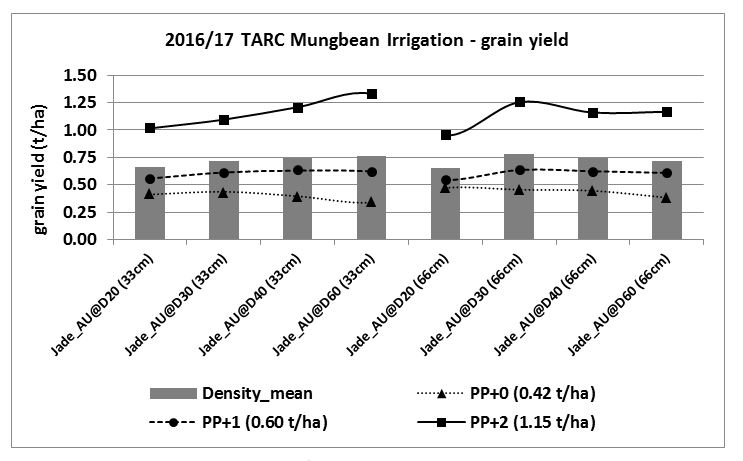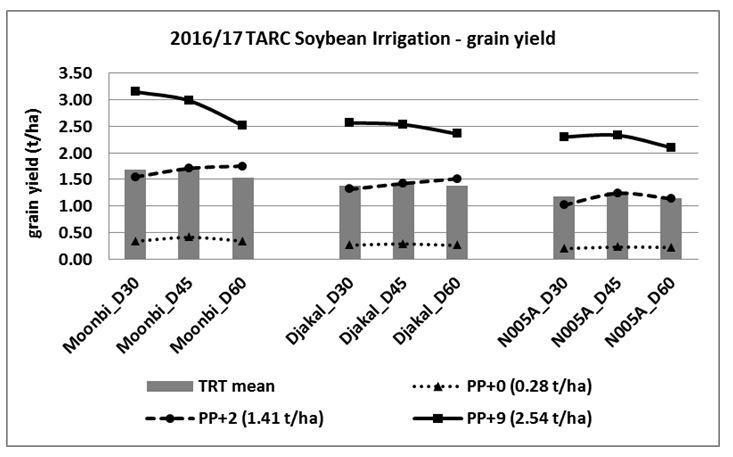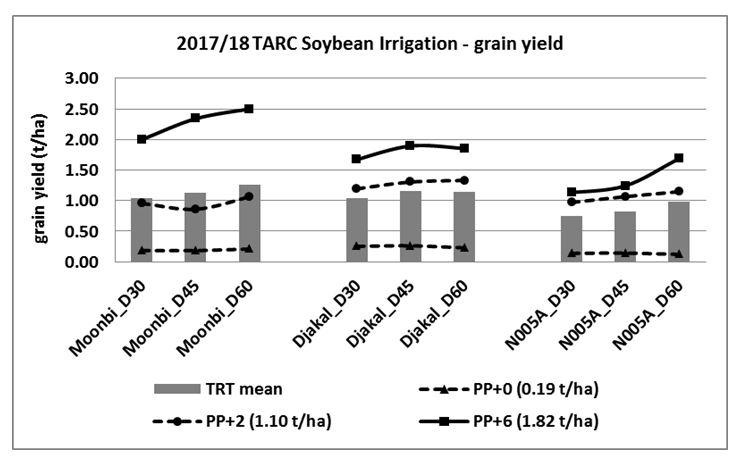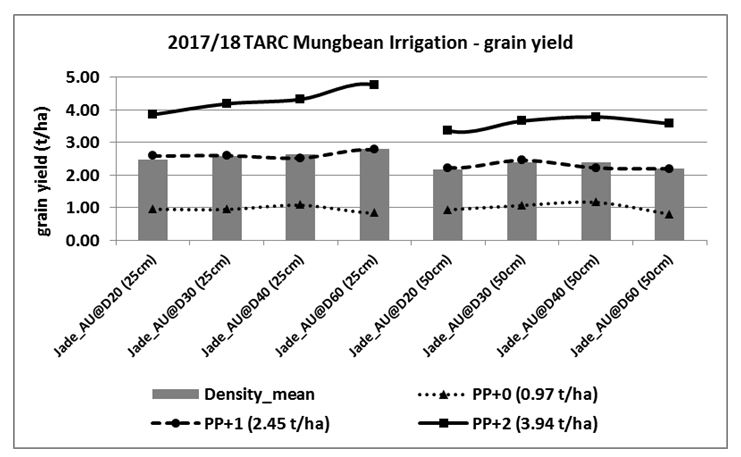Yield performance of dryland mungbean and soybean — Trangie irrigation experiments, 2016/17 and 2017/18
Author: Leigh Jenkins (NSW DPI) | Date: 23 Jul 2018
Take home messages
- Yield potential of mungbean in a dryland cropping situation ranged from 0.5 to 1.0 t/ha when planted on a full soil moisture profile on a grey vertosol soil in two seasons of experiments at Trangie ARC.
- Mungbean has a short growing season (90–120 days) and therefore requires greater agronomic consideration of the impact of sowing date, insect pest management and disease on yield potential.
- Yield potential of soybean in a dryland cropping situation ranged from 0.2 to 0.3 t/ha when planted on a full soil moisture profile on a grey vertosol soil in two seasons of experiments at Trangie ARC.
- Based on these results soybean is not recommended as a dryland summer crop option in the Macquarie valley.
Background
NSW DPI, with support from the GRDC funded Northern Pulse Agronomy Initiative (NPAI) project, has conducted mungbean and soybean management experiments at Trangie over the past five years. The first three years of experiments (2013/14–2015/16) evaluated agronomic interactions including variety, sowing date, plant density and row spacing combinations. These experiments were conducted under full irrigation.
The NPAI project was extended for a further two seasons (2016/17–2017/18) to evaluate water use efficiency (WUE) and yield components by manipulating biomass and irrigation treatments. In essence, this comprised of three irrigation treatments super-imposed over previous agronomic treatments. For both mungbean and soybean experiments, the three treatments included nil, partial and full irrigation scheduling at pre-determined growth stages and adjusted to suit each crop type.
The purpose of this paper (within the context of the Narromine Grains Research Update, to evaluate dryland summer cropping options for central west NSW) is to report yield data for the equivalent of dryland mungbean and soybean in the Macquarie valley over the past two seasons.
Methodology
All four irrigation experiments reported here were sown into a grey vertosol soil at NSW DPI’s Trangie Agricultural Research Centre (Trangie ARC) in central west NSW. The site for each experiment was pre-irrigated prior to sowing to ensure that all treatments started on an equal basis with a full profile of soil moisture. Irrigation treatments were then applied in-crop after establishment. The 2016/17 experiments were flood-irrigated (irrigation treatments located in separate bays of the same field). The 2017/18 experiments were planted on raised beds and watered by siphons, with blank un-watered beds enabling separation of irrigation treatments.
Trial design was a factorial design replicated four times. Agronomic treatments for both mungbean and soybean experiments were the same in both seasons and will be referenced only where applicable in the results. Slight variations in irrigation treatments reflected the conditions for each season and are summarised in Table 1.
Table 1. Irrigation treatment details for 2016/17 and 2017/18 mungbean and soybean experiments at Trangie ARC.
2016/17 | 2017/18 | 2016/17 | 2017/18 | |
|---|---|---|---|---|
pre-plant irrigation (date applied) | 1.5 ML/ha | 2.0 ML/ha | 1.5 ML/ha | 2.0 ML/ha |
sowing date | 29 Nov 2016 | 13 Dec 2017 | 24 Nov 2016 | 30 Nov 2017 |
in-crop rainfall | 203 mm | 131 mm | 203 mm | 131 mm |
1. NIL | PP+0 | PP+0 | PP+0 | PP+0 |
2. PARTIAL | PP+1 | PP+1 | PP+2 | PP+2 |
3. FULL | PP+2 | PP+2 | PP+9 | PP+6 |
Harvest dates | PP+0: 1 Mar 2017 (92 DAS) PP+1: 4 Apr 2017 (126 DAS) PP+2: 2 May 2017 (154 DAS) | PP+0: 23 Mar 2018 (100 DAS) PP+1: 28 Mar 2018 (105 DAS) PP+2: 28 Mar 2018 (105 DAS) | PP+0: 3 May 2017 (159 DAS) PP+2: 11 May 2017 (168 DAS) PP+9: 17 May 2017 (173 DAS) | PP+0: 4 Apr 2018 (125 DAS) PP+2: 4 Apr 2018 (125 DAS) PP+6: 7 May 2018 (158 DAS) |
Total available moisture at each harvest date | PP+0: 275 mm/ha PP+1: 398 mm/ha PP+2: 451 mm/ha | PP+0: 323 mm/ha PP+1: 478 mm/ha PP+2: 628 mm/ha | PP+0: 351 mm/ha PP+2: 451 mm/ha PP+9: 803 mm/ha | PP+0: 328 mm/ha PP+2: 628 mm/ha PP+6: 1231 mm/ha |
Soil tests were conducted for gravimetric analysis (starting and finishing soil moistures) and neutron probes were used in-crop, to assess differences in WUE for selected irrigation and agronomy treatments (data not included). Biomass cuts were taken at flowering (to determine peak biomass) and maturity (to calculate Harvest Index) (data not included). The experiments were managed according to best management practice, however it should be noted that pest pressure was minimal for both the 2016/17 and 2017/18 seasons and very few insecticides were applied in-crop. Plots were harvested by plot header and assessed for yield, seed size and moisture content. Only yield results are presented here; quality data for the 2016/17 season has been completed whilst 2017/18 grain samples are still being processed at time of publication.
Results: mungbean irrigation trials
Grain yield results for all treatments in the 2016/17 and 2017/18 experiments are presented in Figures 1 and 2 below. A single variety of mungbean (Jade_AU) was used in both seasons. Each experiment had the same 24 treatments comprising of 3 irrigation treatments x 4 plant density treatments x 2 row spacing treatments. The raised bed configuration in 2017/18 meant that slightly different row spacing treatments were used in the second year. Results are discussed in terms of the impact of various treatments with particular reference to the NIL irrigation in-crop (i.e. dryland equivalent planted into a full profile).
2016/17 season
- In 2016/17 the NIL irrigation treatment had a shorter growing season of 92 days (based on harvest date as number of days after sowing) when compared to both partial (126 days) and full (154 days) irrigation treatments.
- As such the NIL irrigation treatment was grown on 125 mm of in-crop rainfall from sowing to harvest after 1.5 ML/ha pre-sow irrigation (total available moisture 275 mm/ha).
- Mean yield for all 2016/17 mungbean NIL-irrigation sub-treatments combined was 0.42 t/ha.
- There was a slight increase in yield for the wider row spacing (66 cm) of the NIL irrigation treatment; conversely there was a slight increase in yield for the narrower row spacing (33 cm) in the FULL irrigation treatment; row spacing effect is NOT considered statistically significant overall.
- At both 33 cm and 66 cm row spacing sub-treatments within the NIL irrigation treatment, dryland grain yield was similar for the first three plant densities (20, 30, 40 plants/m2 target density at establishment) but reduced when plant density was increased to 60 plants/m2.

2017/18 season
- In 2017/18 there was very little difference in length of growing season between the three irrigation treatments (100 or 105 DAS) with all treatments reaching physiological maturity at the same time.
- The NIL irrigation treatment was grown on in-crop rainfall of 123 mm from sowing to harvest after 2.0 ML/ha pre-sow irrigation (total available moisture 323 mm/ha).
- Mean yield for all 2017/18 mungbean NIL-irrigation sub-treatments combined was higher than the previous season at 0.97 t/ha.
- There was a slight (not significant) increase in yield for the wider row spacing (50 cm) of the NIL irrigation treatment; however yields were higher at the narrower row spacing (25 cm) in both the PARTIAL and FULL irrigation treatments.
- At both 25 cm and 50 cm row spacing sub-treatments within the NIL irrigation treatment, dryland grain yield was similar for the first three plant densities (20, 30, 40 plants/m2 target density at establishment) but reduced when plant density was increased to 60 plants/m2.
Figure 2. Grain yield response of Jade_AU mungbean sown at four target plant density rates, two row spacing widths and grown under three irrigation treatments at Trangie ARC, 2017/18.
Results: soybean irrigation trials
Grain yield results for all treatments of the 2016/17 and 2017/18 experiments are presented in Figures 3 and 4 below. Three varieties of soybean (Moonbi, Djakal and breeding line N005A) were used in these experiments. Each experiment had the same 27 treatments comprising of 3 irrigation treatments x 3 varieties x 3 plant density treatments. There was no row spacing treatment in the soybean experiments, with a fixed row spacing of 33 cm in 2016/17 and 35 cm in 2017/18. Results are discussed here in terms of the impact of various treatments with particular reference to the NIL irrigation in-crop (i.e. dryland equivalent).
2016/17 season
- In 2016/17 the NIL irrigation treatment had a slightly shorter growing season of 159 days (based on harvest date as number of days after sowing) when compared to both partial (168 days) and full (173 days) irrigation treatments.
- As such the NIL irrigation treatment was grown on 201 mm of in-crop rainfall from sowing to harvest after 1.5 ML/ha pre-sow irrigation (total available moisture 351 mm/ha).
- Mean yield for all 2016/17 soybean NIL-irrigation sub-treatments combined was 0.28 t/ha.
- Under all three irrigation treatments the same pattern of variety response occurred; Moonbi was the highest yielding, followed by Djakal with the breeding line N005A yielding lowest.
- Within the NIL irrigation treatment, dryland grain yield showed no significant response to changes in plant density (30, 45 and 60 plants/m2 target density at establishment) for any of the three varieties.

2017/18 season
- In 2017/18 the NIL irrigation treatment had a much shorter growing season of 125 days (based on harvest date as number of days after sowing) which was the same as the PARTIAL irrigation but over 30 days shorter than the FULL (158 days) irrigation treatment.
- As such, the NIL irrigation treatment was grown on 128 mm of in-crop rainfall from sowing to harvest after 2.0 ML/ha pre-sow irrigation (total available moisture 328 mm/ha).
- Mean yield for all 2017/18 soybean NIL-irrigation sub-treatments combined was 0.19 t/ha.
- There was a variety response to the shorter growing season in 2017/18, Djakal yielded higher than Moonbi under NIL and PARTIAL irrigation treatments; however Moonbi was highest yielding under the FULL irrigation treatment. The breeding line N005A was the lowest yielding variety regardless of irrigation treatment.
- Within the NIL irrigation treatment, dryland grain yield showed no significant response to changes in plant density (30, 45 and 60 plants/m2 target density at establishment) for any of the three varieties.

Discussion
Dryland pulse summer crop options in the Macquarie valley are constrained not only by spring rainfall opportunities (stored soil moisture) but also the amount and timing of rainfall during the summer whilst crops are growing, flowering, setting pods and filling grain. These experiments removed the first constraint by planting on a full profile of stored moisture (pre-sowing irrigation). Despite this there were differences between the two seasons; the 2016/17 season received over 203 mm of in-crop rainfall, whilst the 2017/18 season experienced heatwave conditions in January, February and March 2018, with only infrequent rainfall during that time, resulting in 131mm of in-crop rainfall.
The poor yield response of soybean grown in the equivalent of a dryland cropping situation (i.e. full profile at planting, rain-fed only in-crop) suggests that soybeans are not a profitable option. Maximum yield potential achieved for the NIL irrigation treatment was 0.4 t/ha; average yield potential was less than 0.3 t/ha in 2016/17 and less than 0.2 t/ha in 2017/18. Variety choice would be constrained by predictability of in-crop summer rainfall, with Djakal proving slightly better yielding in short hot growing seasons but Moonbi being the preferred option in longer seasons or partial to fully irrigated (i.e. high rainfall) situations. Previous agronomy research at Trangie ARC has shown that Moonbi must be planted early (before 15 November) to realise full yield potential and enable harvesting before yield and quality are impacted by autumn rainfall in mid-late May.
Mungbean is known to be a much shorter duration crop (usually 90–120 days) which in combination with its indeterminate nature, gives mungbean the ability to respond quickly to in-crop rainfall. This can work for or against the grower depending on the season; it is not unusual to find fully-podded mature plants with a late flush of flowers and the resulting indecision of not knowing when to harvest the crop. Mungbean will also require 90 days of monitoring for various insect pests such as mirids, thrips and heliothis, which can damage flowers and pods very quickly and will require prompt action to control.
The final conundrum with mungbean is that the longer the season the more likelihood of pre-harvest powdery mildew developing after early autumn rainfall, which can then result in a lower yield compared to a drier season. Average yield potential of mungbean in the dryland treatment was less than 0.5 t/ha in the 2016/17 season (powdery mildew present) but up to 1.1 t/ha in the 2017/18 season (no powdery mildew). Jade_AU is the preferred variety planted at a target density of no more than 30 plants/m2. There could be a slight benefit from wider row spacing in some seasons but yield could be reduced in others. Previous agronomy research at Trangie ARC has shown that mungbean should be planted before 15 December; unless the season is very favourable mungbean crops are likely to fail if establishment is attempted during January–February heatwaves.
Summary
Two years of experiments have been conducted at Trangie ARC on a grey vertosol soil, to evaluate mungbean and soybean yield response for a range of agronomic factors in combination with either nil, partial, or full irrigation conditions. The nil irrigation treatment, where the crop was planted on a full soil moisture profile and then received in-crop rainfall only (i.e. no further irrigation) was used to assess the equivalent dryland yield potential for mungbean and soybean crops in the Macquarie valley. From the two seasons of results; mungbean is the preferred dryland summer cropping option, achieving average yields of less than 0.5 t/ha in 2016/17 and less than 1.0 t/ha in 2017/18. Soybean could not be recommended with average yields of less than 0.3 t/ha in 2016/17 and less than 0.2 t/ha in 2017/18.
Further reading
Jenkins, L. (2017) “Evaluation of new mungbean varieties for the Macquarie Valley - Trangie Agricultural Research Centre, 2013 – 2016.” NSW DPI Northern Grains Research Results 2017.
Jenkins, L. (2017) “Evaluation of new soybean varieties for the Macquarie Valley - Trangie Agricultural Research Centre, 2013 – 2016.” NSW DPI Northern Grains Research Results 2017.
Jenkins, L. (2016) “Optimum sowing time and plant density for irrigated mungbean in central west NSW, 2013/14 – 2015-16.” Proceedings of the Australian Pulse Conference, Tamworth NSW, September 2016. Abstract & poster presentation.
Moore, N., Serafin, L., & Jenkins, L. (2014) “Summer crop production guide 2014.” NSW DPI Management Guide.
Acknowledgements
The research undertaken as part of the Northern Pulse Agronomy Initiative project was made possible by the significant contributions of growers through both trial cooperation and the support of the GRDC. The author would like to thank both growers and GRDC for their continued support.
Thanks to Scott Richards, Liz Jenkins, and Joanna Wallace (NSW DPI, Trangie ARC) for technical assistance with all field work and sample processing. Thanks also to Kelvin Appleyard and farm staff at Trangie ARC for their cooperation in providing trial sites and overall crop management for these experiments. This paper was reviewed by Don McCaffery (NSW DPI Technical Specialist) prior to submission.
Contact details
Leigh Jenkins
NSW DPI, Trangie ARC
Trangie NSW
Mob: 0419 277 480
Email: leigh.jenkins@dpi.nsw.gov.au
Varieties displaying this symbol are protected under the Plant Breeders Rights Act 1994
GRDC Project Code: DAN00171,
Was this page helpful?
YOUR FEEDBACK

